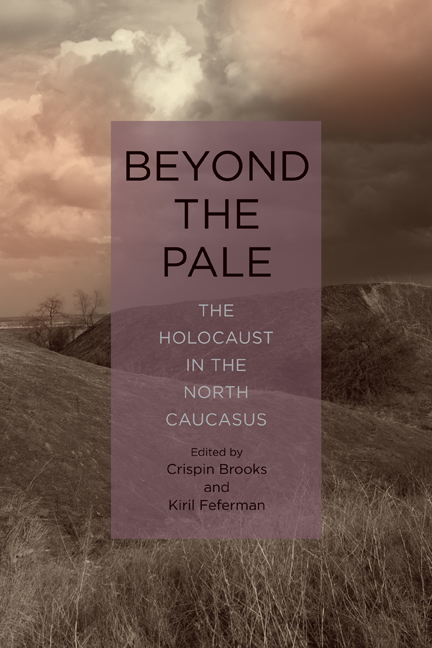Book contents
- Frontmatter
- Contents
- List of Illustrations
- Acknowledgments
- List of Abbreviations
- Note on Terminology
- Introduction
- 1 The Caucasus: A Rock in the Grinding Wheels of World History
- 2 Dwelling at the Foot of a Volcano? Jewish Perspectives on the Holocaust in the North Caucasus
- 3 “Operation Blue,” Einsatzgruppe D, and the Genocide in the Caucasus
- 4 The Kaukasier Kompanie (“Caucasian Company”): Soviet Ethnic Minorities, Collaborators, and Mass Killers
- 5 Mass Executions in Krasnodar Krai: Cross-Checking Sources for the Holocaust in the North Caucasus
- 6 In the Shadow of “Mass Treason”: The Holocaust in the Karachai Region
- 7 Rescue and Jewish-Muslim Relations in the North Caucasus
- 8 “We Were Saved Because the Occupation Lasted Only Six Months”: (Self-)Reflection on Survival Strategies during the Holocaust in the North Caucasus
- 9 The Holocaust on Soviet Territory—Forgotten Story? Individual and Official Memorialization of the Holocaust in Rostov-on-Don
- Glossary
- Bibliography
- List of Contributors
- Index
5 - Mass Executions in Krasnodar Krai: Cross-Checking Sources for the Holocaust in the North Caucasus
Published online by Cambridge University Press: 06 October 2020
- Frontmatter
- Contents
- List of Illustrations
- Acknowledgments
- List of Abbreviations
- Note on Terminology
- Introduction
- 1 The Caucasus: A Rock in the Grinding Wheels of World History
- 2 Dwelling at the Foot of a Volcano? Jewish Perspectives on the Holocaust in the North Caucasus
- 3 “Operation Blue,” Einsatzgruppe D, and the Genocide in the Caucasus
- 4 The Kaukasier Kompanie (“Caucasian Company”): Soviet Ethnic Minorities, Collaborators, and Mass Killers
- 5 Mass Executions in Krasnodar Krai: Cross-Checking Sources for the Holocaust in the North Caucasus
- 6 In the Shadow of “Mass Treason”: The Holocaust in the Karachai Region
- 7 Rescue and Jewish-Muslim Relations in the North Caucasus
- 8 “We Were Saved Because the Occupation Lasted Only Six Months”: (Self-)Reflection on Survival Strategies during the Holocaust in the North Caucasus
- 9 The Holocaust on Soviet Territory—Forgotten Story? Individual and Official Memorialization of the Holocaust in Rostov-on-Don
- Glossary
- Bibliography
- List of Contributors
- Index
Summary
Prior to the German occupation of August 1942, a large number of evacuees had arrived in Krasnodar krai. Although in 1939 only 7,351 Jews lived there (0.2 percent of the region's total population), tens of thousands of Jews were placed in its cities and villages after the outbreak of war in the summer of 1941. Of the 218,000 people officially evacuated to the region in August 1941, over 160,000 (73 percent) were Jewish. Additionally, an unknown but significant number of people came individually, without the help of the state structures. More Jews arrived during the spring and summer of 1942. They came from Ukraine, Rostov oblast, or Leningrad, driven by fear of the news of German atrocities. Upon arrival, they were usually placed throughout the district—in the cities, villages, kolkhozes, and sovkhozes, with the help of the local population. Once the German advance into the region began in late summer 1942, many had no way of leaving and eventually found themselves under German occupation.
During the six months of occupation (August–February 1943), over 15,660 Jews were executed in almost fifty different cities and villages throughout Krasnodar krai. Nearly the entire Jewish population living in the region at the time of the German occupation was exterminated, and Jews comprised around 90 percent of all the civilian victims there during World War II. The killings were carried out from the end of summer to the autumn of 1942 by Teilkommandos of Einsatzkommando 11 as well as units of Sonderkommando 10a.
As thousands of evacuees had been assigned to rural areas and particularly to kolkhozes, it is not surprising that these demographically less important places became mass execution sites. The executioners had at their disposal information from the local administration about the evacuees, including the “Jewish nationality” of some of them. This enabled them to identify Jewish families living in such remote villages.
By studying the executions in Krasnodar krai, we can observe geographic and time details. The data show that three-quarters of the victims were killed within the first two months of the occupation, in August (over 8,500 victims) and September (over 4,100 victims) 1942.
- Type
- Chapter
- Information
- Beyond the PaleThe Holocaust in the North Caucasus, pp. 118 - 144Publisher: Boydell & BrewerPrint publication year: 2020



